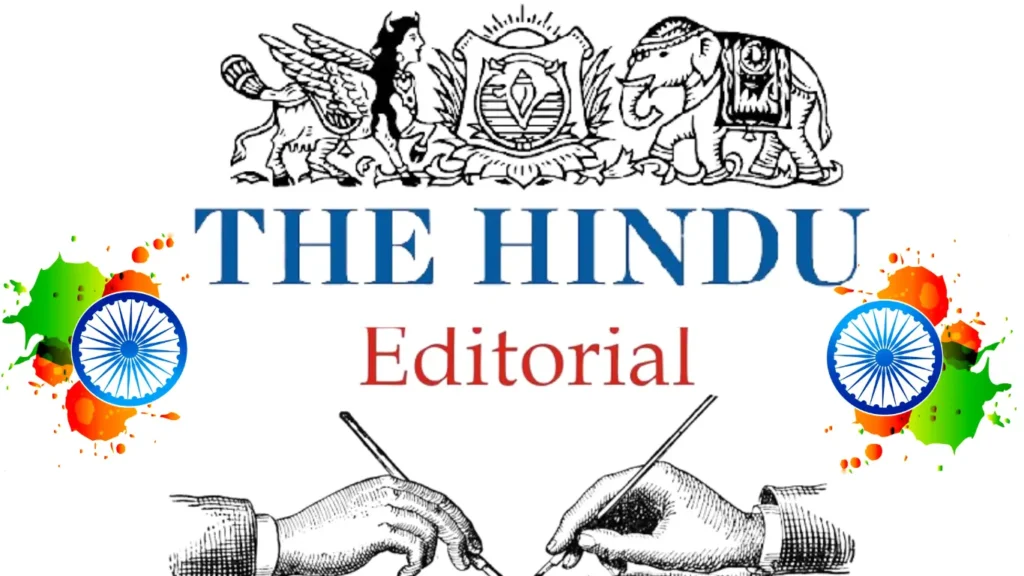Analysis of The Hindu Editorial 1: The other monsoon
Context
India’s agricultural output is deeply intertwined with its monsoon seasons. The Southwest and Northeast monsoons each play pivotal roles in shaping the country’s rainfall patterns and, consequently, its economy. While the Southwest monsoon is often the focal point, the Northeast monsoon is equally important, particularly for specific regions like Tamil Nadu. To better prepare for climate changes, it is essential to improve the forecasting and modeling of the Northeast monsoon’s impact.
Introduction
The 2024 Southwest monsoon season closed on a positive note, with rainfall surpassing expectations by 8%. The India Meteorological Department’s (IMD) accurate forecast, especially from July onwards, has been reassuring for the agricultural sector. Now, as the rains shift, so does the nation’s focus—towards the less-discussed yet significant Northeast monsoon.
Shifting Focus to the Northeast Monsoon
Monsoons and the Indian Economy
Monsoon clouds still hover over various parts of the country, but the spotlight has now turned to the “other monsoon,” the Northeast monsoon. Though less prominent, this season plays a critical role in sustaining the agriculture-dependent economy, particularly in southern India.
Understanding the Winds
The term “Northeast monsoon” derives from the direction of the winds as they shift from land to sea following the Southwest monsoon’s retreat. This wind pattern reversal signals the start of the rain-bearing season in southern coastal regions.
Characteristics of the Northeast Monsoon
The Northeast monsoon kicks off after the Southwest monsoon withdraws around mid-October. A noticeable reversal in wind direction brings vital rainfall to parts of coastal Andhra Pradesh, Tamil Nadu, Kerala, and southern Karnataka. For Tamil Nadu, in particular, this season is the main source of rain, contributing substantially to the region’s agricultural output. However, on a national scale, the Northeast monsoon only accounts for about 11% of India’s total annual rainfall.
Forecast for Post-Monsoon Rainfall
The IMD has predicted that this year’s post-monsoon rainfall will likely exceed normal levels by about 12% compared to historical averages. Though less extensive than the Southwest monsoon, the Northeast monsoon significantly impacts crops such as rice and maize in Tamil Nadu and Andhra Pradesh. In years with rainfall shortages, agricultural productivity in these areas suffers a steep decline, emphasizing the importance of accurate forecasts.
The Impact of Rainfall Variability
Geographic Variations
The Northeast monsoon’s rainfall is highly inconsistent across the five main regions it affects, showing a variation of up to 25%, which is more volatile than the Southwest monsoon’s 10% variation. This inconsistency can result in extreme weather patterns—ranging from torrential downpours to prolonged dry spells.
Monsoonal Changes and Socio-Economic Impact
In 2015, Chennai experienced devastating floods during the Northeast monsoon, leading to significant loss of life and property. Fast forward to 2019, the same city faced a severe water shortage. This extreme fluctuation underscores the challenges posed by monsoonal variability. If the current forecasts hold true, this could mark the second consecutive year of a normal Northeast monsoon, offering some stability.
Expectations and Challenges Ahead
Influence of La Niña
A key factor influencing this year’s forecast is the presence of La Niña—a cooling of the equatorial Pacific waters—which could bolster monsoonal rainfall. However, accurately predicting La Niña’s timing has posed challenges for global models, creating uncertainty around the exact rainfall impact.
Advancements in Forecasting Systems
Despite these challenges, improvements in weather forecasting systems have made the Northeast monsoon less of a mystery than in previous years. Accurate predictions are critical to managing both agricultural productivity and urban flood risks.
Conclusion
In light of increasing climate change unpredictability, more attention must be given to the Northeast monsoon’s role in urban flooding and disaster management. With better modeling, state disaster management agencies can incorporate these risks into their planning and budgets, providing essential buffers against climate-induced variability. While the Southwest monsoon grabs more headlines, the Northeast monsoon remains a crucial determinant of agricultural success and risk mitigation in southern India. Enhanced forecasting, coupled with proactive disaster management strategies, will be key in reducing the potential impacts of climate change and rainfall variability.
- [PDF] Kiran SSC 10600+ General Awareness Book English
![[PDF] Kiran SSC General Awareness Book English](https://savepdf.in/wp-content/uploads/2024/12/PDF-Kiran-SSC-10600-General-Awareness-Book-English-1156x650.webp)
- [PDF] – Manorama Yearbook 2025: A Comprehensive Guide to Knowledge and Exam Success

- [PDF] Blackbook 25000+ GA English Medium
![[PDF] Blackbook 25000+ GA English Medium](https://savepdf.in/wp-content/uploads/2024/11/PDF-Blackbook-25000-GA-English-Medium-1156x650.webp)
- [PDF] Reasoning Made Easy – Download Now
![[PDF] Reasoning Made Easy](https://savepdf.in/wp-content/uploads/2024/11/Reasoning-Made-Easy-1156x650.webp)
- [PDF] Police Recruitment Challenger – Download Now
![[PDF] Police Recruitment Challenger](https://savepdf.in/wp-content/uploads/2024/11/Police-Recruitment-Challenger-1156x650.webp)
Analysis of The Hindu Editorial 2: Caste in jail
Context
A recent Supreme Court decision has highlighted the unconstitutional nature of certain rules and practices in India’s jails, particularly those rooted in caste-based discrimination. This ruling calls for immediate action from state governments to dismantle systemic discrimination within prison systems, aligning them with the ideals of equality enshrined in the Constitution.
Introduction
One of the most striking elements of the Supreme Court’s recent judgment on caste-based discrimination in prisons is that it required intervention from the country’s highest court to address these deeply entrenched, colonial-era practices. Despite decades of independence, such discriminatory systems have persisted, underscoring the need for systemic reform in prison administration.
Lack of Action Since Independence
Revisiting the Jail Manual
The Court’s ruling draws attention to specific rules in the jail manuals across various states, where caste-based hierarchies continue to influence the assignment of duties, the classification of prisoners, and the designation of certain social groups as “habitual offenders.”
Absence of Government Action
Despite these glaring issues, both state and central governments have largely failed to address this discriminatory structure in the nearly eight decades since independence. The lack of meaningful reform reveals a troubling disconnect between the ideals of the Constitution and the reality within prison walls.
Philosophy of the Constitution
The prison system appears to operate in isolation from the core values of the Indian Constitution, which mandates:
- The creation of an equal society,
- The eradication of all forms of discrimination,
- The prohibition of untouchability, and
- The abolition of forced labor and exploitation.
Responding to the Writ Petition
Judicial Perspective
In its judgment, the Supreme Court critically examined the controversial rules and practices that perpetuate caste-based discrimination in prisons. It ruled these provisions unconstitutional, directing state governments to revise their prison manuals within three months.
Historical Context
The Court also traced the origins of these practices to colonial rule, stating that the British administration linked caste with prison labor, food distribution, and the overall treatment of prisoners. This connection laid the foundation for a discriminatory system that continues to echo today.
The Historical Context of Prison Administration
Menial Work and Hereditary Trades
Historically, prisoners from lower-caste communities were assigned menial or so-called “polluting” jobs. These individuals were often required to perform what the Court described as their “hereditary trades” within the prison, reinforcing caste-based occupational segregation. Meanwhile, prisoners from higher castes enjoyed certain privileges, further entrenching this hierarchical divide.
Caste-Based Privileges
The practice of maintaining caste privileges in prison settings, such as allocating food preparation duties based on caste, was another glaring issue highlighted by the Court. Assigning jobs like manual scavenging, sweeping, and cleaning exclusively to individuals from lower castes blatantly violated the constitutional ban on untouchability.
| Discriminatory Practices in Jail | Constitutional Violations |
|---|---|
| Menial jobs assigned based on caste | Violation of dignity and equality |
| Food cooked by prisoners of “suitable caste” | Breach of constitutional rights |
| Hereditary trades enforced in prison | Reinforcement of caste hierarchy |
A Question on Rights
Distribution of Labor
The Court stressed that prison labor should not be distributed based solely on birth. Such practices violate fundamental rights, including the right to dignity and the prohibition against forced labor.
Vague Definitions of Offenders
Another significant aspect of the judgment was the call to eliminate vague definitions of “habitual offenders.” Such classifications often unfairly attribute criminal tendencies to entire communities, perpetuating harmful stereotypes even though the notion of “criminal tribes” has been long abandoned.
| Issue | Court’s Stance |
|---|---|
| Caste-based allocation of labor | Unconstitutional, violates the right to dignity |
| “Habitual offenders” classification | Based on outdated and discriminatory colonial notions |
Conclusion
The Supreme Court’s ruling presents an essential opportunity for state governments to revise their prison administration rules and eliminate caste-based discrimination. This is a crucial moment to align prison practices with constitutional values, ensuring that prisons uphold the ideals of equality and justice. Ending systemic discrimination in such a critical institution is not just about reform—it’s about reaffirming the nation’s commitment to creating a society free from exploitation and prejudice.

